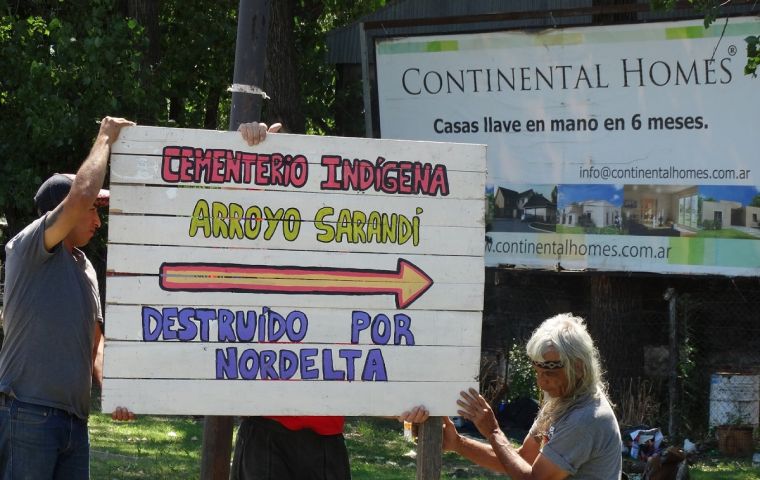MercoPress. South Atlantic News Agency
Argentina: Indigenous communities want to bury ancestors in Nordelta
 “It takes a while to define where they will be buried ... but it is a place in Nordelta,” Chara said.
“It takes a while to define where they will be buried ... but it is a place in Nordelta,” Chara said. The bodies of 42 members of an indigenous community who were removed from their resting places by US archaeologist Samuel Lothrop in 1925 are to be restored to their historical land in what will be the largest restitution carried out so far in Argentina and which has been approved Monday by the National Institute of Indigenous Affairs (INAI).
The remains of 42 ancestors of the Indigenous Community of Punta Querandí will be returned to their communities, who will now have to find a way to build up a cemetery in the middle of the most exclusive Nordelta residential area, north of Buenos Aires.
“There is going to have to be a cemetery within Nordelta. It's what they wanted to avoid. A strong fight is coming, but I think we are going to win it. They got them out of there, they have to be there,” said Santiago Chara, a descendant of a lineage of Qom chiefs that dates back to the 19th century, a member of the Punta Querandí Council of Elders and an authority of the Qom Cacique Ramón Chara de Benavidez Community.
“From our worldview we feel very happy that they can return to the land where they belong and should not have left. They are ancient cultures and the place was not respected by real estate developments. Some bodies were removed before, but others [were] when they made the neighborhoods [they built the real estate developments],” Chara said.
“For us it is something very sacred that they return, we feel more complete. There was a hole to plug and it is being completed. There are still bodies missing, but we are ensuring that they are returned and our culture is respected, which was invisible for a long time,” Chara went on.
After a ceremony of “cleaning and safeguarding” due to the presence of “negative energies”, the process will continue once the remains reach the territory. “It takes a while to define where they will be buried. It has to be where they came from or from a nearby place. It is a place in Nordelta, you are looking for the point and knowing what is there now. When it is found, it will be buried again by means of another ceremony. It has to be within the closed neighborhood, because it was taken from there.”
The claim for the remains of this community began in 2009. The process was carried out in coordination with the Council for Indigenous Participation of the province of Buenos Aires (CPAI), the National Institute of Latin American Anthropology and Thought (Inapl) and the INAI. In June and December those first burials took place.
“This is the second stage of a restitution request that has completed a decade. In March 2021 we delivered eight ancestors who are already buried, seven of them in their sacred sites, and the eighth in community territory. Now we are going to close the cycle by ending this second stage to put an end to these long-standing claims,” said Fernando Miguel, coordinator of the Area of Identification and Restitution of Indigenous Human Remains and Protection of Sacred Sites of the INAI.
Indigenous specialists point out Lothrop worked for the United States intelligence service, using his career as a front to gather strategic information in the countries that he traveled. Lothrop was one of the few foreigners who were allowed to conduct excavations in Argentine territory, but documents implicating him in his work have not yet been declassified. Other papers from others countries that he visited as an archaeologist did come to light, it was reported.




Top Comments
Disclaimer & comment rulesCommenting for this story is now closed.
If you have a Facebook account, become a fan and comment on our Facebook Page!